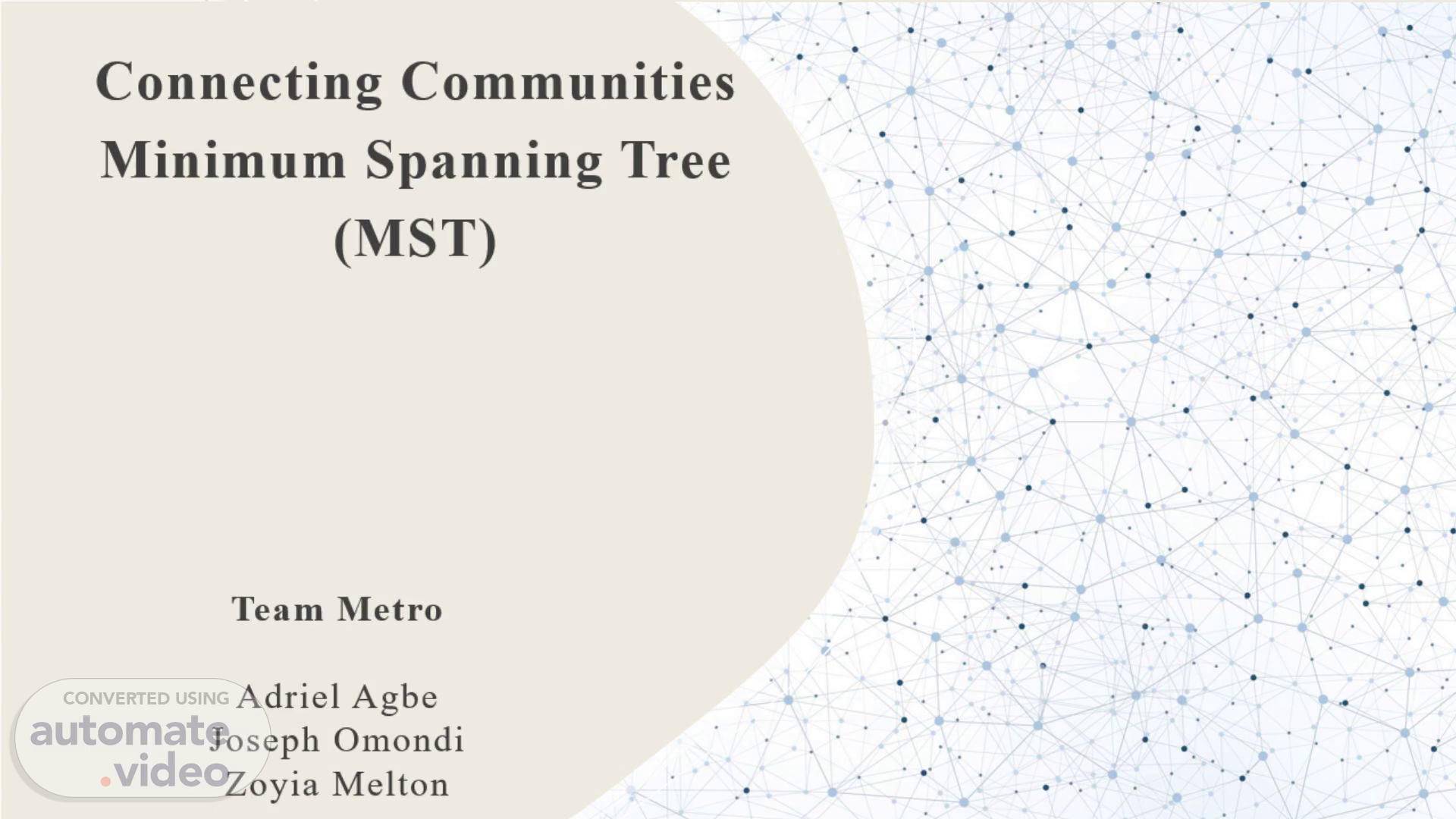Scene 1 (0s)
[Audio] Hello and welcome to Team Metro's MST Project for Connecting power to Communities..
Scene 2 (9s)
[Audio] Our team members are Adriel Agbe(Developer), Joseph Omondi(Developer), and Zoyia Melton(Project Manager)..
Scene 3 (20s)
Abstract. Head with Gears.
Scene 4 (29s)
[Audio] Our focuses on the efficiency of a cable-laying network, connecting homes to a main utility provider. Our main goal is to minimize the cost of installation while making sure all homes are running, under constraints such as max cable length..
Scene 5 (47s)
[Audio] We implemented CMSTs, specifically the BDMST to compare with BCMST using python. We will evaluate metrics such as cost, runtime, and constraint violations. We created simulated graphs and visualized the base and CMST through Matplotlib. We have also created a GitHub repo for our documentation..
Scene 6 (1m 12s)
Background Info. [image].
Scene 7 (1m 21s)
[Audio] For our background, city structure efficiency in planning is crucial for reducing the installation cost and improved service delivery. A major real-world challenge is designing a cable network for connecting homes, under the constraint of installation cost and length..
Scene 8 (1m 40s)
[Audio] For a change in our background info, we decided to remove the concept of redundancy, as it felt like an unnecessary focus for the scope of this project. We now focus on the limited length of the cable edges..
Scene 9 (1m 54s)
[image] Angled shot of pen on a graph. Progress Report.
Scene 10 (2m 4s)
[Audio] For our progress report, we faced initial challenges with the loss of two team members, but we successfully managed to reorganize the roles and tasks. We modified our weekly plans and milestones..
Scene 11 (2m 21s)
Programming Based. [image] Computer script on a screen.
Scene 12 (2m 30s)
[Audio] The time complexity for our project is in about O(n log n) for the main algorithm, with O(n) for the diameter..
Scene 14 (3m 21s)
Self-evaluate - Schedule. [image] Writing an appointment on a paper agenda.
Scene 15 (3m 31s)
[Audio] For self evaluation, we are currently on track with tasks. We have adjusted our timeline after losing team members. Our make-up plan modified initial milestones and shifted focus on the foundational MST concepts..
Scene 16 (3m 49s)
[Audio] For our future work, we will revisit the BDMST and BCMST benchmarks through comparisons. We will also conduct performance evaluations and documentation..
Scene 17 (4m 2s)
Prognosis and Future Work.
Scene 18 (4m 11s)
[Audio] For our prognosis, we are on schedule, despite the delays we are almost caught up with our initial tasks. We have also adjusted our weekly goals to help us return to schedule..
Scene 19 (4m 27s)
[Audio] For our make-up plan, we postponed modifying and evaluating tasks for upcoming milestones. We will focus on completing all critical components first. We will also reallocate extra work sessions for finishing pending updates..
Scene 20 (4m 42s)
[Audio] For our future workplan, we will validate the BDMST and BCMST comparisons, finalize evaluation metrics, prepare documentation and visualizations, and ensure our initially delayed tasks are completed..
Scene 21 (5m 0s)
Reference. Books.
Scene 22 (5m 8s)
[Audio] These are our references for our benchmark MSTs. Thank you..
